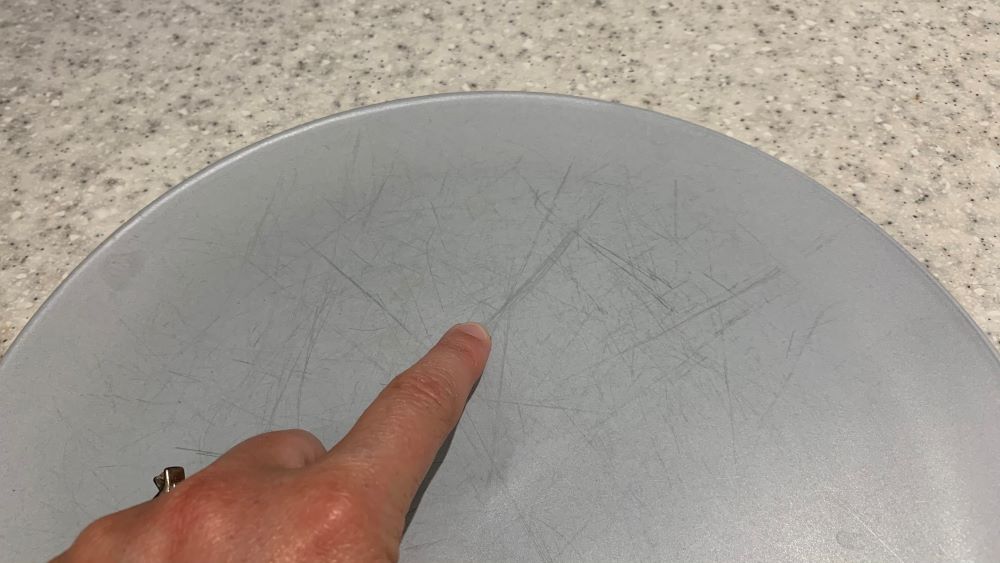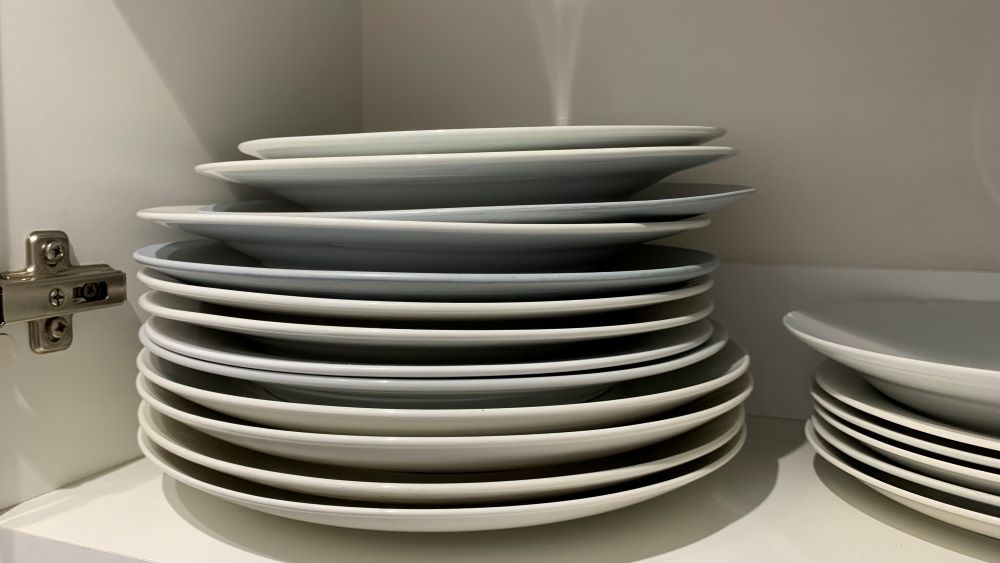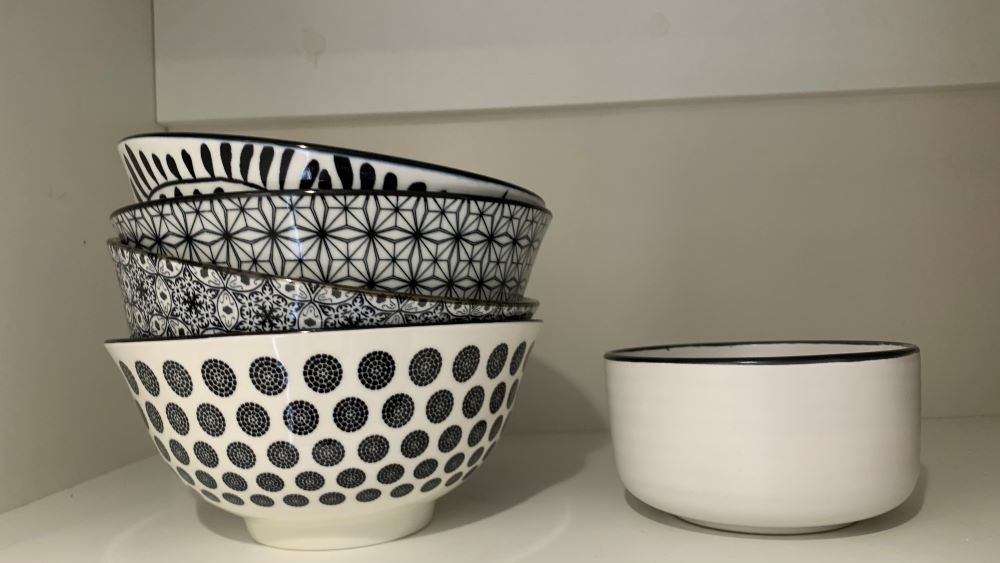Stoneware that is good quality and fired at a high temperature will resist scratches. The use of sharp cutlery on stone plates can cause marks and scratches over time. These can be reduced by gently scrubbing the dish or plate with a nylon brush.
This article will explore all you need to know about scratches on stoneware. This includes why they happen, how to prevent them and how to remove them if they occur.

Scratches on cheap stoneware
Stoneware that is made cheaply with little or no glazing can scratch easily. I bought stone plates and they scratched within a few weeks. These were very cheap but they still work well. Light colored plates will end up with grey scratches from cutlery.
Scratches on good quality stoneware
To prevent scratches on stoneware it is best to choose the best quality plates and dishes you can afford. This will usually mean the plates have been made from good quality materials, are baked at a high heat and good quality hard glazes are used to protect them.
Glazes will create a shiny coating on the dish which will help to waterproof the plates or dishes. This means that they will be easier to clean, less likely to scratch and waterproof so they don’t absorb colors or smells.

How to choose stoneware that will resist scratches
Here are my top tips for choosing stoneware that will resist scratches for as long as possible. Generally speaking, the more expensive stoneware will last longer without developing scratches. Here are a few things to look out for when choosing your stoneware dishes or plates.
1. Choose stoneware that is fired at very high temperatures
Top quality stoneware will be fired or baked at very high temperatures after the dish has been shaped. This will create a strong, hard finish and make them more resistant to scratches. To know if the stoneware has been fired at a high temperature, check out the website of the manufacturer.
Good manufacturers will describe their manufacturing process. A top quality brand that makes top quality stoneware includes Pampered Chef.
Check out Pampered Chef on Amazon here.

2. Choose stoneware with good quality glazing
Look out for good quality glazing when you are choosing your stoneware. Inspect it yourself to make sure it looks flat and that there is no marks. Look out for bubbles or areas where the glaze has not completely covered the dish.
3. Choose dark colored stoneware
Dark colored stoneware will hide scratches better than a light colored dish. My light gray plates were scratched within weeks. Dark colors can hide the dark scratches made by utensil or when the plate rubs against other dishes.
Even stacking plates roughly can cause them to rub against each other and scratch. Take care when placing them in your cupboard and gently stack them if you can.
What causes scratches on stoneware
Here are a few things to look out for that can increase the chance that plates will rub against each other and become scratched.
1. The use of aluminum or stainless steel cutlery
Using cutlery on plates and dishes made of stone can increase the chance that they will become scratched. Choosing the best quality stoneware can help to prevent scratches.
2. Stacking plates on top of each other
Stacking plates on top of each other in cupboards or drawers can cause them to rub and scratch each other. Take care when stacking the plates in your cupboard and aim to do this gently.

3. Plates or dishes rubbing against them in the dishwasher
Placing stoneware dishes against others in the dishwasher can cause them to scratch each other. Whether they are touching other stone dishes or ceramic ones, scratches can happen.
Always space the plates further apart to allow room to avoid them rubbing and scratching each other. Leave at least a space width between them to prevent them from knocking into each other as you open and close the dish drawer.
4. Cutting food directly on the dish
If you are cutting tough food like meat directly on stoneware dishes you do risk scratch them. Most of the scratches on my dishes have come from using stake knives directly on the plate.
Avoid chopping foods straight onto the stoneware with sharp kitchen knives. Always use a chopping board and transfer the food over.
6. Mixing dishes with metal spoons or spatulas
If you are cooking a casserole or stew in a stoneware dish it is best to use a non-stick or soft spoon or spatula. Using metal utensils can scratch the stoneware when you mix.
How to remove scratches or marks on stoneware dishes
Here is a few easy steps to remove scratches on stoneware dishes. This is an easy homemade cleaner that is gentle.
- Make a paste with baking soda and water
- Rub it into the scratches with a sponge or cloth
- Allow it to stand for 5 minutes
- Wash it off in warm soapy water
You can also get commercial stoneware cleaners from hardware stores. These also work well to remove marks or scratches from stoneware plates.

Benefits of top quality stoneware
- Very durable
- Can be glazed which keep them looking shiny
- Most good quality glazed dishware is microwave and dishwasher safe
- Stoneware plates can be warmed at low temperatures in the oven
Overtime the use of silverware or cutlery on the plate can leave scratches. The higher quality the plate the longer they will last without scratches.
Mild abrasive cleaners can be used to minimize the scratches but take care if the plate has a glaze. It can reduce the glaze thickness over time
Does Stoneware Scratch Easily? | Summary
Cheap stoneware can scratch easily if you use sharp utensils on the plates or dishes or if they rub up against each other. To prevent scratches pick the best quality stoneware you can afford, choose a dark color and make sure you stack them away from other dishes in the dishwasher. Make a bicarbonate of soda paste and rub the plate gently to remove small scratches.
Happy cooking.
I am an accredited practicing dietitian, experienced gardener and a dedicated cook. I love writing and sharing my experience so you can learn from my successes and mistakes.
